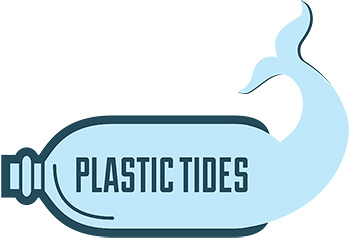
Celine Jennison '14, foreground, and Gordon Middleton '14 were part of the Plastic Tides crew paddleboarding around Bermuda last summer to draw attention to plastics pollution. Photo: Julian Rodriguez
Plastic Tides founders chart microbeads' threat to N.Y. waters
How ya gonna keep 'em down on the farm after they "SUP" Bermuda?
Answer: The emerging environmental threat of plastic microbeads in Cayuga Lake is what brought Christian Shaw '14 back, following a 10-day circumnavigation of Bermuda on stand-up paddleboards (SUPs) last summer to draw public attention to larger, seaborne plastic waste.
Discarded plastic bottles, shopping bags and chunks of rigid foam are cleared from waterfronts of Ithaca and other communities by volunteers. What those bottle-gathering folks were missing, Shaw says, is literally under their noses: microscopic polyethylene spheres (microbeads) in many manufactured beauty products, including those silky skin creams.
The sub-millimeter beads function as lubricants, exfoliants and delivery agents for cosmetic chemicals. Washed down the drain, the tiny beads slip through wastewater treatment plants with hardly a notice, and into aquatic ecosystems. Toxins attach to the microbeads, becoming more concentrated with each marine organism that passes the chemical-laden spheres along the food chain.

While several states pondered legislation to ban cosmetic microbeads, Shaw and Cornell classmate Gordon Middleton '14, who co-founded the advocacy organization Plastic Tides, couldn't wait.
With winter coming on and Gordon Lightfoot lyrics ("… the gales of November came early …") stuck in their heads, they launched a freshwater SUP expedition. They were determined to paddle 240 miles from Ithaca to Albany via the historic Erie Canal route (now called the New York State Canal System) while trawling for microbeads.
Freezing rain and wind-blown snow -- thanks to a November polar vortex -- didn't stop the paddle-boarding explorers. Impassable ice at Little Falls, New York, did. They climbed out of the canal, packed the paddleboards and took 180 miles' worth of water samples for lab analysis at the State University of New York at Fredonia.
"The results were sobering," says Shaw. "We found microbeads from Cayuga Lake, Oneida Lake, the Erie Canal and the Mohawk River. Seventy percent of the samples contained beads. And in Cayuga Lake, the highest abundance measured was 69,000 beads per square kilometer of surface sampled, with an average of 15,000 beads per square kilometer." (They sample only the surface of the water because that is primarily where the beads stay.)
Sojourning in warmer climes (Hawaii) while Cayuga Lake freezes over, the Plastic Tides crew is already plotting a return to Cayuga Lake this summer. They hope to recruit a network of youthful paddlers (with kayaks, canoes, stand-up boards) who can learn scientific collection methods and continue the plastics survey in this and other Finger Lakes.
So that's what brings back a townie Cornellian -- environmental concern and a fondness for the place. "I have family and friends and it's a really awesome place to live. Not many people are so fortunate to have been born and raised somewhere they really enjoy," he writes from the 50th state.
As might be expected from grads of the College of Agriculture and Life Sciences, a scientific paper about the microbead survey is in the works. And a video documentary, too.